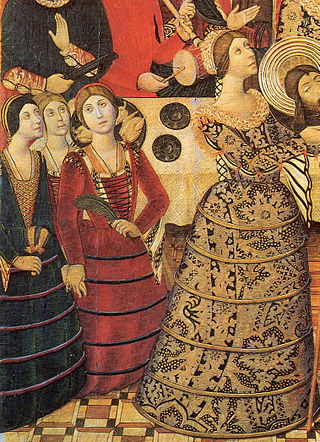
A farthingale is one of several structures used under Western European women's clothing - especially in the 16th and 17th centuries - to support the skirts in the desired shape and to enlarge the lower half of the body. The fashion originated in Spain in the fifteenth century. Farthingales served important social and cultural functions for women in Renaissance Europe as they expressed, primarily when worn by court women, high social position and wealth.

A ruff is an item of clothing worn in Western, Central, and Northern Europe and Spanish America from the mid-16th century to the mid-17th century. The round and flat variation is often called a millstone collar after its resemblance to millstones for grinding grain.

A stomacher is a decorated triangular panel that fills in the front opening of a woman's gown or bodice. The stomacher may be boned, as part of a stays, or may cover the triangular front of a corset. If simply decorative, the stomacher lies over the triangular front panel of the stays, being either stitched or pinned into place, or held in place by the lacings of the gown's bodice.
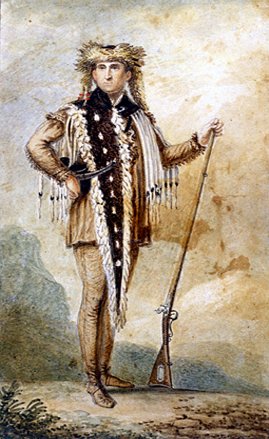
A tippet is a piece of clothing worn over the shoulders in the shape of a scarf or cape. Tippets evolved in the fourteenth century from long sleeves and typically had one end hanging down to the knees. A tippet could also be the long, narrow, streamer-like strips of fabric - attached with an armband just above the elbow - that hung gracefully to the knee or even to the ground. In later fashion, a tippet is often any scarf-like wrap, usually made of fur, such as the sixteenth-century zibellino or the fur-lined capelets worn in the mid-18th century.
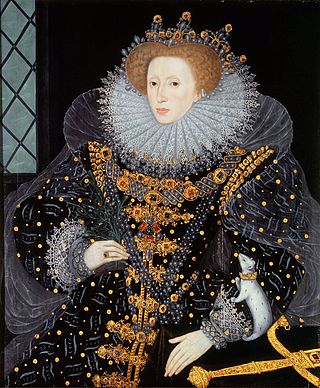
Fashion in the period 1550–1600 in European clothing was characterized by increased opulence. Contrasting fabrics, slashes, embroidery, applied trims, and other forms of surface ornamentation remained prominent. The wide silhouette, conical for women with breadth at the hips and broadly square for men with width at the shoulders had reached its peak in the 1530s, and by mid-century a tall, narrow line with a V-lined waist was back in fashion. Sleeves and women's skirts then began to widen again, with emphasis at the shoulder that would continue into the next century. The characteristic garment of the period was the ruff, which began as a modest ruffle attached to the neckband of a shirt or smock and grew into a separate garment of fine linen, trimmed with lace, cutwork or embroidery, and shaped into crisp, precise folds with starch and heated irons.

Fashion in the period 1600–1650 in Western clothing is characterized by the disappearance of the ruff in favour of broad lace or linen collars. Waistlines rose through the period for both men and women. Other notable fashions included full, slashed sleeves and tall or broad hats with brims. For men, hose disappeared in favour of breeches.

Fashion in the period 1500–1550 in Europe is marked by very thick, big and voluminous clothing worn in an abundance of layers. Contrasting fabrics, slashes, embroidery, applied trims, and other forms of surface ornamentation became prominent. The tall, narrow lines of the late Medieval period were replaced with a wide silhouette, conical for women with breadth at the hips and broadly square for men with width at the shoulders. Sleeves were a center of attention, and were puffed, slashed, cuffed, and turned back to reveal contrasting linings.

The French hood is a type of woman's headgear that was popular in Western Europe in the 16th century.
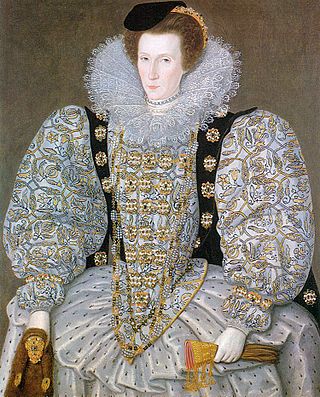
A zibellino, flea-fur or fur tippet is a women's fashion accessory popular in the later 15th and 16th centuries. A zibellino, from the Italian word for "sable", is the pelt of a sable or marten worn draped at the neck or hanging at the waist, or carried in the hand. The plural is zibellini. Some zibellini were fitted with faces and paws of goldsmith's work with jeweled eyes and pearl earrings, while unadorned furs were also fashionable.

The Armada Portrait of Elizabeth I of England is the name of any of three surviving versions of an allegorical panel painting depicting the Tudor queen surrounded by symbols of royal majesty against a backdrop representing the defeat of the Spanish Armada in 1588.

An overskirt is a type of women's short skirt which is draped over another garment, such as a skirt, breeches, or trousers. Although peplum is often used as another term for overskirt, it should not be confused with the peplos or "peplum dress", which was worn in ancient Greece.
Mary Radcliffe or Ratcliffe (1550-1617) was a courtier of Queen Elizabeth I of England.

Aura Soltana, also known as Ipolitan the Tartarian or Ipolita or Ippolyta, was a Tartar woman at the court of Elizabeth I after arriving from Russia to England, apparently as a slave.
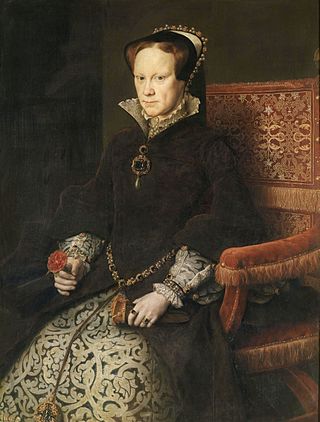
An inventory of the jewels of Mary I of England, known as Princess Mary or the Lady Mary in the years 1542 to 1546, was kept by her lady in waiting Mary Finch. The manuscript is now held by the British Library. It was published by Frederic Madden in 1831. Some pieces are listed twice. Two surviving drawings feature a ribbon with the inscription, "MI LADI PRINSIS". The British Library also has an inventory of the jewels she inherited on coming to the throne in 1553.

Several documents list the jewels of Margaret Tudor, daughter of Henry VII of England and Elizabeth of York. Margaret married James IV of Scotland in 1503.

Oes or owes were metallic O-shaped rings or eyelets sewn on to clothes and furnishing textiles for decorative effect. Made of gold, silver, or copper, they were used on clothing and furnishing fabrics and were smaller than modern sequins. They were made either from rings of wire or punched out of a sheet of metal.
A silkwoman was a woman in medieval, Tudor, and Stuart England who traded in silks and other fine fabrics. London silkwomen held some trading rights independently from their husbands and were exempted from some of the usual customs and laws of coverture. The trade and craft of the silkwoman was encouraged by a statute of Henry VI of England as a countermeasure to imports of silk thread, and a suitable occupation for "young gentlewomen and other apprentices".
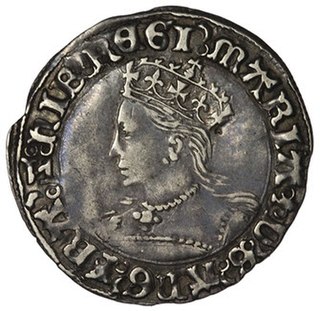
The coronation of Mary I as Queen of England and Ireland took place at Westminster Abbey, London, on Sunday 1 October 1553. This was the first coronation of a queen regnant in England, a female ruler in her own right. The ceremony was therefore transformed. Ritual and costume were interlinked. Contemporary records insist the proceedings were performed "according to the precedents", but mostly these were provisions made previously for queens consort.
A chamberer was a female attendant of an English queen regnant, queen consort, or princess. There were similar positions in aristocratic households.

Walter Fyshe was a London tailor who worked for Elizabeth I until 1582. He also made some of her farthingales. Fyshe made the queen's ceremonial clothes and coronation robes, altering robes made for the coronation of Mary I of England.


























